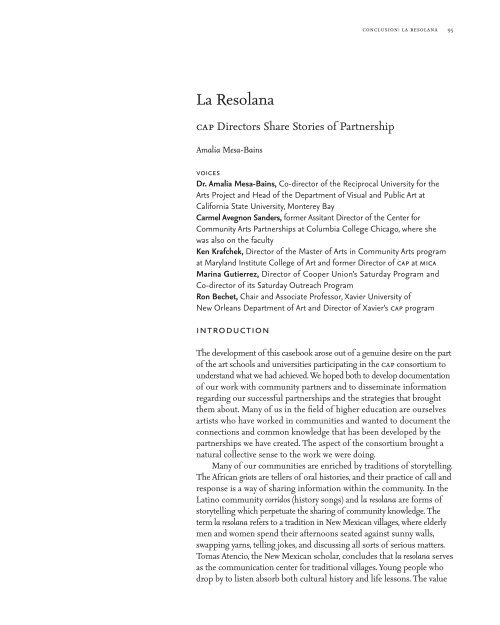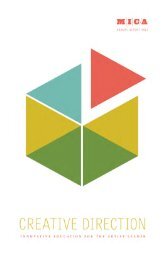art/vision/voice - Maryland Institute College of Art
art/vision/voice - Maryland Institute College of Art
art/vision/voice - Maryland Institute College of Art
You also want an ePaper? Increase the reach of your titles
YUMPU automatically turns print PDFs into web optimized ePapers that Google loves.
La Resolana<br />
cap Directors Share Stories <strong>of</strong> P<strong>art</strong>nership<br />
Amalia Mesa-Bains<br />
<strong>voice</strong>s<br />
Dr. Amalia Mesa-Bains, Co-director <strong>of</strong> the Reciprocal University for the<br />
<strong>Art</strong>s Project and Head <strong>of</strong> the Dep<strong>art</strong>ment <strong>of</strong> Visual and Public <strong>Art</strong> at<br />
California State University, Monterey Bay<br />
Carmel Avegnon Sanders, former Assitant Director <strong>of</strong> the Center for<br />
Community <strong>Art</strong>s P<strong>art</strong>nerships at Columbia <strong>College</strong> Chicago, where she<br />
was also on the faculty<br />
Ken Krafchek, Director <strong>of</strong> the Master <strong>of</strong> <strong>Art</strong>s in Community <strong>Art</strong>s program<br />
at <strong>Maryland</strong> <strong>Institute</strong> <strong>College</strong> <strong>of</strong> <strong>Art</strong> and former Director <strong>of</strong> cap at mica<br />
Marina Gutierrez, Director <strong>of</strong> Cooper Union’s Saturday Program and<br />
Co-director <strong>of</strong> its Saturday Outreach Program<br />
Ron Bechet, Chair and Associate Pr<strong>of</strong>essor, Xavier University <strong>of</strong><br />
New Orleans Dep<strong>art</strong>ment <strong>of</strong> <strong>Art</strong> and Director <strong>of</strong> Xavier’s cap program<br />
introduction<br />
conclusion: la resolana 95<br />
The development <strong>of</strong> this casebook arose out <strong>of</strong> a genuine desire on the p<strong>art</strong><br />
<strong>of</strong> the <strong>art</strong> schools and universities p<strong>art</strong>icipating in the cap consortium to<br />
understand what we had achieved. We hoped both to develop documentation<br />
<strong>of</strong> our work with community p<strong>art</strong>ners and to disseminate information<br />
regarding our successful p<strong>art</strong>nerships and the strategies that brought<br />
them about. Many <strong>of</strong> us in the field <strong>of</strong> higher education are ourselves<br />
<strong>art</strong>ists who have worked in communities and wanted to document the<br />
connections and common knowledge that has been developed by the<br />
p<strong>art</strong>nerships we have created. The aspect <strong>of</strong> the consortium brought a<br />
natural collective sense to the work we were doing.<br />
Many <strong>of</strong> our communities are enriched by traditions <strong>of</strong> storytelling.<br />
The African griots are tellers <strong>of</strong> oral histories, and their practice <strong>of</strong> call and<br />
response is a way <strong>of</strong> sharing information within the community. In the<br />
Latino community corridos (history songs) and la resolana are forms <strong>of</strong><br />
storytelling which perpetuate the sharing <strong>of</strong> community knowledge. The<br />
term la resolana refers to a tradition in New Mexican villages, where elderly<br />
men and women spend their afternoons seated against sunny walls,<br />
swapping yarns, telling jokes, and discussing all sorts <strong>of</strong> serious matters.<br />
Tomas Atencio, the New Mexican scholar, concludes that la resolana serves<br />
as the communication center for traditional villages. Young people who<br />
drop by to listen absorb both cultural history and life lessons. The value
















